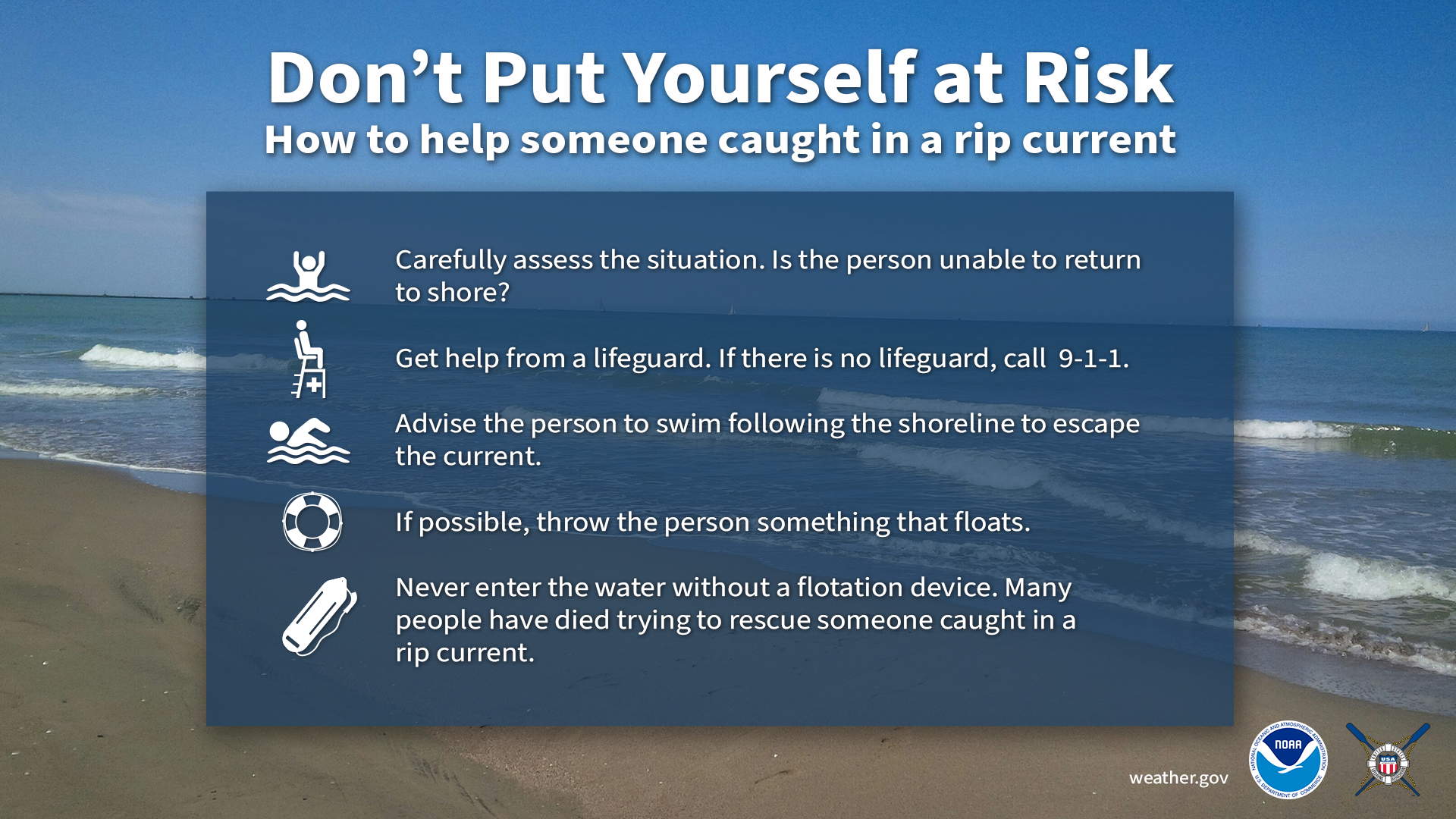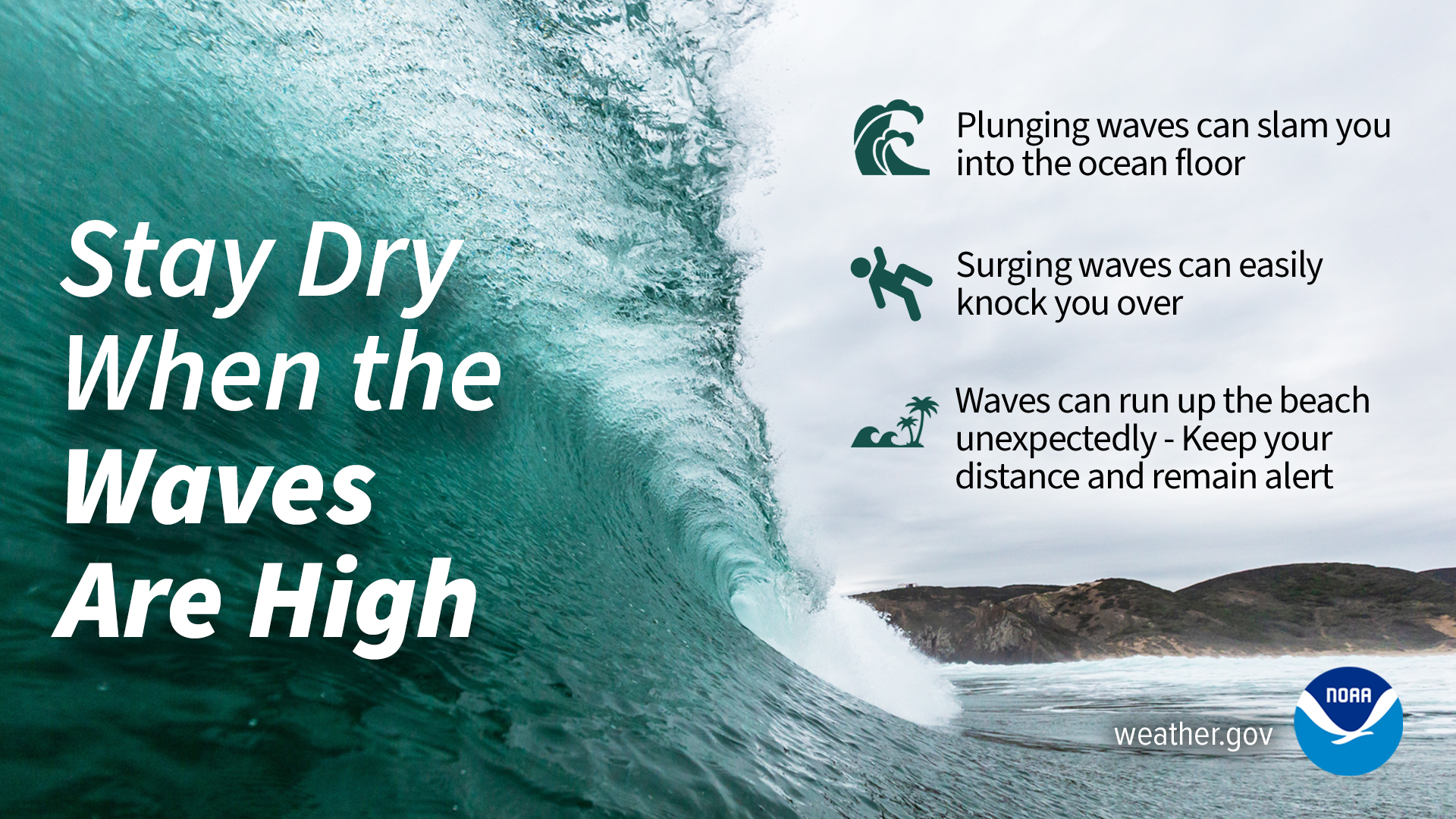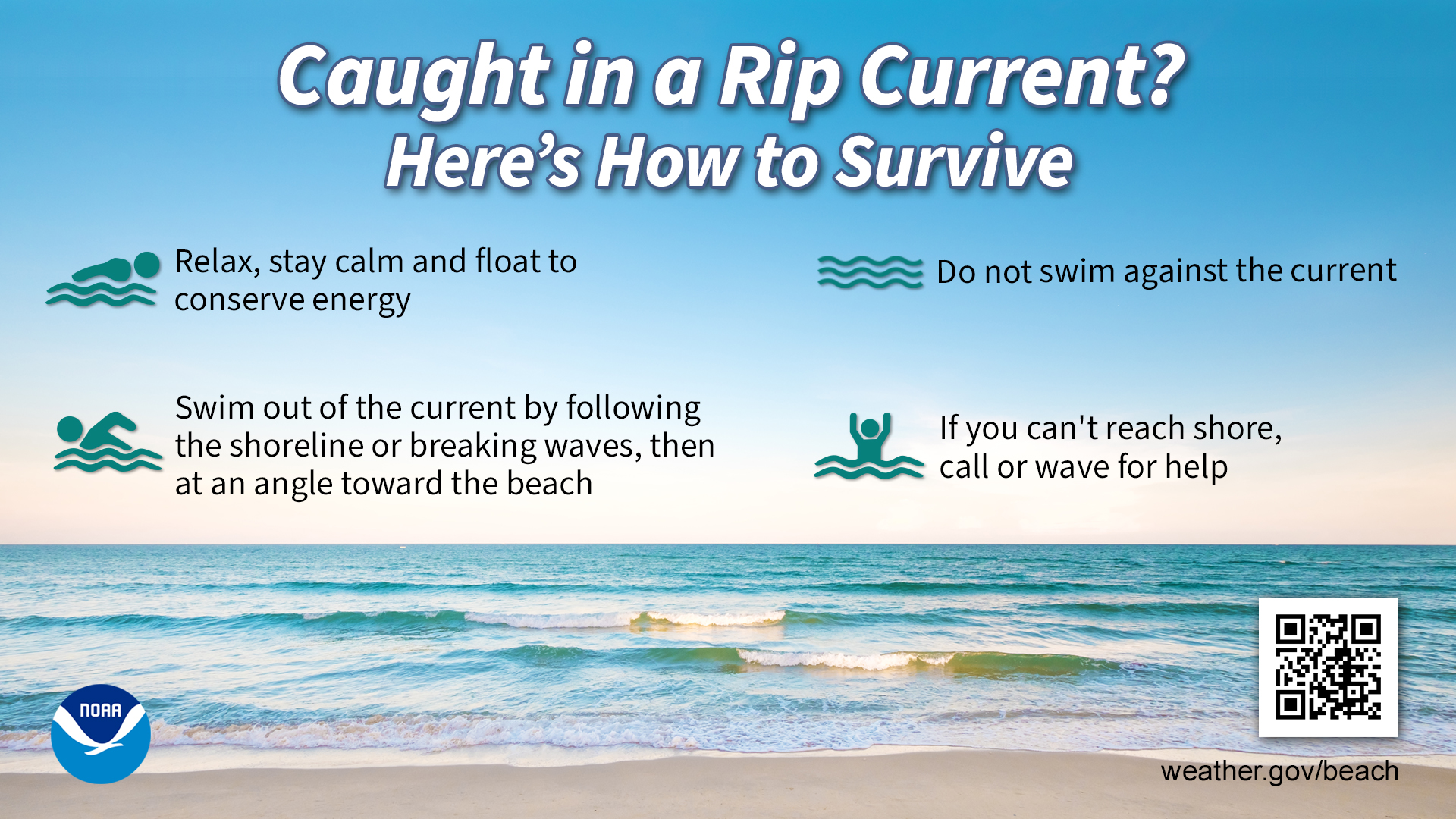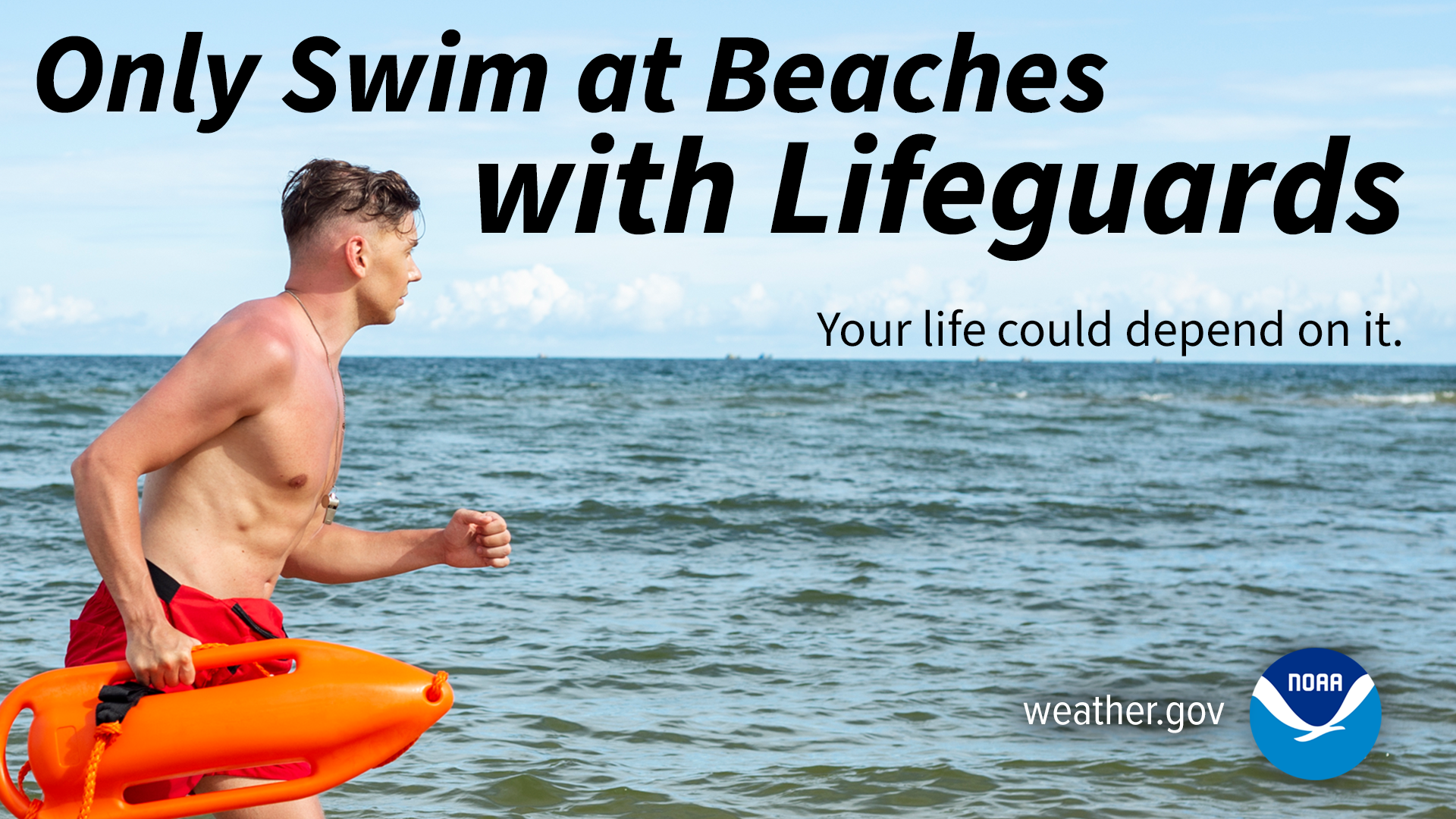Please help the National Weather Service spread these important safety messages on social media! Everyone is welcome to use the text and images provided below to help the NWS build a Weather-Ready Nation.
Facebook
If someone is caught in a rip current, help them without putting yourself at risk. Seek help from a lifeguard or use a floatation device if you go in the water. Learn more at: https://www.weather.gov/wrn/summer-safety
Twitter
If someone is caught in a rip current, help them without putting yourself at risk. Seek help from a lifeguard or use a floatation device if you go in the water. Learn more at: https://www.weather.gov/wrn/summer-safety #WeatherReady

Stay Dry When the Waves Are High! Crashing waves can be beautiful to look at, but it’s easy to underestimate their power. Stay aware of your surroundings along the shore, as waves can quickly catch you off guard. weather.gov/safety/beachazards
Twitter
Stay Dry When the Waves Are High! Crashing waves can be beautiful to look at, but it’s easy to underestimate their power. Stay aware of your surroundings along the shore, as waves can quickly catch you off guard. weather.gov/safety/beachazards #WeatherReady

Facebook
Rip currents can sweep even the strongest swimmer away from shore. If at all possible, stay near a lifeguard while swimming. Learn more at: weather.gov/beach
X/Twitter
Rip currents can sweep even the strongest swimmer away from shore. If at all possible, stay near a lifeguard while swimming. Learn more at: weather.gov/beach #WeatherReady

Facebook
At the beach, remaining vigilant and knowing when to speak up can save someone’s life.
If you meet someone from out of town, let them know about the dangers of rip currents and other beach hazards.
If someone is waving or yelling for you: don’t panic, take 10 seconds to assess the situation, then immediately alert a lifeguard. While help is coming, see if there’s a floatation device you can throw to them. Don’t attempt a rescue on your own.
weather.gov/safety/beach
Twitter
At the beach, remaining vigilant and knowing when to speak up can save someone’s life. #WeatherReady
weather.gov/safety/beach

Facebook
Rip currents kill over 100 beachgoers in the U.S. each year. When visiting the ocean, you are safest at beaches with lifeguards. Stay Weather-Ready and learn more about rip current safety at weather.gov/safety/ripcurrent
Twitter
Rip currents kill over 100 beachgoers in the U.S. each year. When visiting the ocean, you are safest at beaches with lifeguards. Stay #WeatherReady and learn more about rip current safety at weather.gov/safety/ripcurrent

Facebook
From New Jersey to American Samoa, we have some of the most amazing beaches in the world. This Wave Safe video series from Ocean Today visits the country's favorite shores to teach you about the unique waves and weather at each location.
oceantoday.noaa.gov/every-full-moon/episode15-wavesafe/
Twitter
From New Jersey to American Samoa, we have some of the most amazing beaches in the world. NOAA’s Wave Safe video series visits the country's favorite shores to keep you #WeatherReady at each location.
oceantoday.noaa.gov/every-full-moon/episode15-wavesafe/

Facebook
“Then I realized the ocean was gonna win.”
Luckily, Jake remembered to “swim parallel to the shoreline” -- the most important safety tip for escaping and surviving a rip current. Learn more at weather.gov/ripcurrent
Twitter
“Then I realized the ocean was gonna win.”
Luckily, Jake remembered to “swim parallel to the shoreline” -- the most important safety tip for escaping and surviving a rip current. Learn more at weather.gov/ripcurrent #WeatherReady

Facebook
The United States Lifesaving Association (USLA) estimates that over 100 people die each year due to rip currents in the US. Break the Grip of the Rip®! weather.gov/safety/ripcurrent
Twitter
Every year, over 100 people die from rip currents in the US. Break the Grip of the Rip®! weather.gov/safety/ripcurrent #WeatherReady

Facebook
The United States Lifesaving Association (USLA) advises beachgoers to enter the water feet first. The USLA says, “serious, lifelong injuries, including paralysis, occur every year due to diving headfirst into unknown water and striking the bottom.” Check for depth and obstructions before diving. weather.gov/safety/beachhazards
Twitter
To avoid injuries at the beach, always enter the water feet first.weather.gov/safety/beachhazards #WeatherReady

Facebook
The difference in the air temperature and water temperature can be drastic and deceptive. Be aware of your surroundings, and always wear a life jacket. weather.gov/safety/coldwater
Twitter
The difference in the air temperature and water temperature can be drastic and deceptive. Be aware of your surroundings, and always wear a life jacket. #WearIt weather.gov/safety/coldwater #WeatherReady

Facebook
The sun’s ultraviolet (UV) rays can damage your skin in as little as 15 minutes. Follow these recommendations from the CDC to help protect yourself and your family: cdc.gov/cancer/skin/basic_info/sun-safety.htm
Twitter
The sun’s ultraviolet (UV) rays can damage your skin in as little as 15 minutes. Follow these recommendations from @CDCgov to help protect yourself and your family: cdc.gov/cancer/skin/basic_info/sun-safety.htm
Even when it’s sunny, you’ve gotta be #WeatherReady!

Facebook
Rip currents are powerful, narrow channels of water in the surf zone that move quickly away from shore. Moving at speeds of up to eight feet per second (or 5 mph!), rip currents can move faster than an Olympic swimmer. https://oceantoday.noaa.gov/ripcurrentscience/welcome.html #RipCurrentScience #SummerSafety
Twitter
Rip currents are powerful, narrow channels of water flowing away from shore at surf beaches and can reach speeds of 8 feet per second! #WeatherReady https://oceantoday.noaa.gov/ripcurrentscience/welcome.html

Facebook
Trips to the beach aren't always fun in the sun. From strong rip currents to dangerous marine life, discover the Nine Dangers at the beach. oceanservice.noaa.gov/news/features/july13/beachdangers.html
Twitter
Have fun at the beach, but be safe! Discover the Nine Dangers at the beach: oceanservice.noaa.gov/news/features/july13/beachdangers.html #WeatherReady

Facebook
Did you know that the chance of drowning at a beach with on-duty lifeguards is 1 in 18 million? Swim at a beach only when there is an on-duty lifeguard. weather.gov/safety/beachhazards
Twitter
Did you know the chance of drowning at a beach with on-duty lifeguards is 1 in 18 million? Swim at a beach only when there is an on-duty lifeguard. weather.gov/safety/beachhazards #WeatherReady

Facebook
Spending time in the sun on vacation this spring? Apply plenty of sunscreen! Also, keep in mind that heat-related illness is a possibility if you don’t take certain precautions. Find out more about heat-related illnesses and how to prevent them at weather.gov/safety/heat-illness
Twitter
Spending time in the sun? Apply sunscreen and avoid heat-related illness: weather.gov/safety/heat-illness

Facebook
When outdoors in the heat, wear lightweight, loose-fitting, and light-colored clothing to reflect heat and sunlight. If you will be spending time outdoors, hats are also a good idea to protect your face and scalp from harmful UV rays. Also, don’t forget to apply sunscreen liberally. weather.gov/safety/heat
Twitter
Protect yourself when outdoors in the heat. weather.gov/safety/heat
